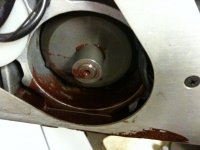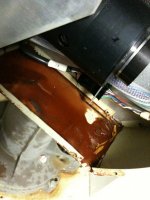Is all lost?
Is all lost?
Ariel,
The cable is a straight through (at least mine is) Pin 1 goes to pin1 ect…
On my unit I have 2 cables.
The first (labeled J0A or just A) is smaller, it has 24 pins.
The first 12 pins are the motors. They appear to be 24Vdc brush motors so they are nothing special in the electronics sense.
As I mentioned in an earlier post they are paired 12,34,56,78,9-10,11,12
The next 5 pins are not used.
The last 7 pins are a bit more mysterious but with a little more work I could figure them out. They consist of the 24V supply to disengage the electric brakes on the joints,
Plus some other signal lines. Possibly a limit or safety sensor loop.
Each joint has a sine-encoder that has 4 wires connected to it. Additionally there are 3 sires that are connected to a variable resistor, or more accurately a potentiometer, and finally a ground wire. That makes 8 wires per joint.
Although I only have 6 joints on my unit, I noticed that the Circuit board in the base has an extra and unused connection for a 7th joint. So That makes 7 * 8 = 56 wires for the joint position sensors.
Allied Electronics carries the connectors that were used on the PUMA units so they are not hard to replace, the hard part is finding a cable. I would first look for some multi conductor wires and build the cable in bundles. LAN wiring uses 8 conductor wire so using a spool of CAT 4 wire you could run one length for each joint and then wire tie the whole bundle together when you are done. (For the Larger plug of course)
The smaller plug, for the first 12 wires, I would use a thicker wire because those wires provide the power to the motors. No less than 18ga. Don’t use speaker wire though.
Part of a wires current handling capability is it’s ability to disperse heat. Lamp cord and speaker wires have thick insulations on them that are meant to protect the wire from home owners who put chairs on them. They often overheat and cause fires because the think insulation keeps the heat trapped in the wire. Thinner insulation can be used for this application because the current the puma pulls is not high enough to overheat the wire.
On the issue of the software. I am working on that for you. I think that there may be a way to get you a copy of software. The issue I am checking into is how compatible the versions of the software are between the controllers.
The hardware changed quickly when the Pumas were being built so there seem to be a few different models. Plus the company changed hands a few times and each new owner put their own stamp on the product.
If you could send me all the serial numbers, model numbers and even any version numbers written on the EPROM chips in the controller I will try to find a match or donor for you.
The teach pendant might be a minor issue, I have seen them show up fairly cheap at times on ebay. But as a light of hope, The teach pendant is nothing more than a Serial terminal just like the VDT.
The only difference would be the E-Stop button on the top and the Dead-man switches on the back and on the side, and the speed/Slow switch . I am studying my pendant to see how I can write an emulator program to run on the PC.
The dead man switches and the E-Stop could be hardwired. And the Speed switch could be replaced with a simple toggle switch.
Once I get the communications down, the rest should be easy.
So in short, there is still hope.. Keep looking for parts and if you find spares, check with any other puma people you find. You might be able to swap parts for the ones you need.
-Mike



